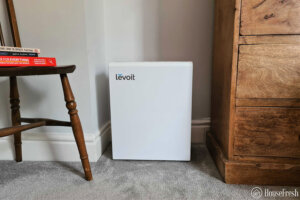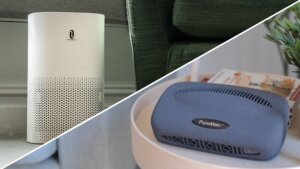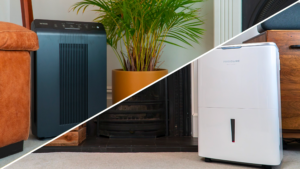As much as we love our pets, they may inadvertently be causing us serious health problems. Approximately 10-20% of the world’s population is affected by cat or dog allergies, and your pet’s dander is to blame.
We’ll look into some of the reasons why dander can be so problematic for people’s health.
Yet, while it can feel upsetting knowing how much your adorable pet may be impacting your health, there are many things you can do to minimize the risks.
Around 7 out of 10 US households have one or more pets in the home. However, there can be a big disadvantage to pet ownership: allergies.
While some might believe that an animal’s fur or hair triggers allergic reactions, this isn’t the case. As the AAFA points out, the proteins found in the flakes of skin – known as dander — and those in the animal’s urine and saliva can cause health problems.
Pet dander is microscopic and can remain in the air inside your home for a long time. It can also cling to surfaces, furniture and even clothing. This means that, yes, it’s probably everywhere. This may not be too much of an issue for those who aren’t affected by animal allergies, but it can be difficult (and upsetting when you adore your pet pal) if your health is suffering.
Yet why does dander pose such a threat?
Well, suppose your immune system is susceptible. In that case, your animal’s allergens, such as the dander, can get into the membranes that line your eyes and nose, causing symptoms such as:
👃 Stuffy nose
💧 Runny nose
🤧 Sneezing
😮💨 Coughing
🥺 Itchy eyes
Pet dander can be especially problematic for people with asthma. This is because the allergens are airborne and can get inside your lungs, which may trigger an attack if you do have asthma. Most people with asthma show symptoms soon after exposure to the allergens, yet some may not experience any problems until a few hours later.
Keep reading for effective ways to rid your home of pet hair. We’ll also look at why air purifiers can be particularly beneficial and give you a heads-up about our device recommendations.
10 ways to get rid of pet hair in the air
To help ease your symptoms, here are some great ways to remove pet hair.
1. Groom your pet
Healthy dogs and cats shed fur to keep their coats looking tip-top. But you can help reduce the amount of hair they lose (and how much of it gets spread around your home) by brushing them regularly. Try to maintain a proper grooming schedule. If you have a dog, the Animal Humane Society recommends brushing your pooch every couple of days, irrespective of coat length.
| Grooming Type | Schedule | Pro Tip |
| Bathing | Every two to four months — or when your dog has gotten dirty. Warning: Bathing him too frequently will dry out his skin and strip the natural oils from his coat. | Make sure to use a shampoo that’s made for dogs. Human shampoo can be too harsh for your puppy’s skin and coat. |
| Brushing | You should brush your dog every couple of days no matter the length of his coat. | Keep your sessions short at first and increase the length of time as your dog learns to enjoy it. |
| Feet | Regularly trimming your dog’s foot hair keeps tar, rocks, ice balls, salt, and other debris from getting caught in the feet. | Use a scissors to trim the hair growing over the top of your dog’s foot and around the paw pads so that the hair is level with the paw pads. Do not try to trim in between the toes. |
| Nails | Nails should be checked and clipped about every two weeks. | Pick a pet nail clipper that feels comfortable in your hands, has a clear line of sight to where the blade is cutting, and a sharp blade. |
| Ears | Clean your dog’s ears about once a week. | Use a cotton ball or a piece of gauze with ear cleaning solution, or a baby wipe wrapped around your finger. Don’t use water because it doesn’t evaporate very easily. |
| Teeth | Clean your dog’s teeth two to three times per week. | Use a piece of gauze wrapped around your finger, a finger cap scrubber made for pet teeth cleaning or a toothbrush designed for dogs. |
A bad diet will often result in excessive shedding, so focusing on a high-quality diet, including meat, fresh fruit, veggies and clean, fresh water can improve the strength of your pet’s coat. Read this advice on the best diet for cats and for dogs.
2. Vacuum regularly
Vacuuming at least twice a week will help to remove hairs, whether you have a cat or dog. Any hoovering will help, but a vacuum with a HEPA filter is a good idea, as these are especially effective at removing allergens like dander. If you are the proud owner of a long-furred dog or live in a multi-pet household, you might need a high powered vacuum with additional filters to remove large volumes of pet hair and pet dander. Our top choice is the Bissell Pet Hair Eraser Turbo – affordable and light-weight.
Be sure to vacuum things like sofas and chairs with the appropriate attachments and carpets and floors.
Remember to empty your vacuum regularly, as pet hairs can easily block it, impacting its effectiveness.
3. Choose the right surfaces
You may not be renovating your home at the moment, but replacing carpets with hard floorings like wood or vinyl will help enormously. Hard floors repel hair and are much easier to clean than carpets. And while a velvet sofa sounds heavenly, it’s best to go for cotton as this will be much more resistant to pet hairs.
The same thing applies to your bedding: pet hair will attach itself to woollen bed throws, so think about investing in synthetic or cotton materials.
4. Wash bedding
Washing your cat or dog’s bedding frequently can reduce the amount of hairs – and eliminate any pet pongs! Adding a liquid water softener or half a cup of white vinegar to the cycle can further help to loosen hair in the washing machine. And don’t forget to check the drum afterwards for any hairs that might have got stuck inside.
Don’t forget to wash your pets’ toys, too. Every couple of weeks should be sufficient and you can simply use detergent and hot water.
5. Use a blanket on problem areas
Following on from tip 4, if your pet has a favorite spot on the sofa or an armchair, putting a blanket down means that you can throw that in the washer, too. A blanket (or rug) will act as an effective barrier between your furry friend and the furniture and helps prevent dander from getting everywhere. If you can, be sure to put the blanket in the washing machine on a weekly basis.
Give the blanket a good shake outside after it’s gone through the washer to eliminate residual hairs.
6. Clean and dust with a damp cloth
Running a damp cloth along anywhere that your pet has been will really help to get rid of the hair. Microfiber cloths and sponges are especially good and you can run them across surfaces as well as skirting boards and walls. You can also use a damp mop on hard floors.
If you normally use fabric softener sheets in your dryer, you can dampen one of these as they’re also great for picking up pet hairs.
7. Use rubber gloves
Rubber gloves protect your hands while cleaning, but did you know they can also remove pet hairs? All you need to do is wet them gently and brush them over fabrics. The texture of the gloves in combination with the static created will help lift off pet hairs from sofas and hard-to-reach places like the corners of staircases.
Remember to clean the gloves after use by giving them a good soak in hot water, which enables the hair to come away easily.
8. Get rid of clutter
Reducing the amount of clutter in your home means that there are fewer places for pet hair to latch onto and get into, particularly those little nooks and crannies. Unhealthy allergens have less chance of sticking around if you declutter regularly. It also does cleaning and vacuuming a whole lot easier.
As well as knickknacks and small items, don’t forget that clothing and dishes left lying around also count as clutter and can pick up dander.
9. Use lint rollers
If you have a cat or a dog, you may already have a lint roller for your clothes. They’re quick, easy to use and, best of all, cheap. But these nifty little things are also great at removing pet hair from upholstery and curtains. Be sure to roll them over your fabrics regularly.
- Sticky tape can work similarly. With the sticky side up, wind the tape around your hand and brush it against furniture, fabric or clothes.
- There are two main choices for lint rollers: disposable or reusable. If you’re going for a disposable roller, we recommend the Scotch-Brite Lint Roller. If you prefer a reusable lint roller, then the ChomChom Pet Hair Roller is the way to go.
10. Keep pets away from certain areas
It’s not easy when you don’t want to part from your beloved kitty or canine but restricting pets from your bedroom can significantly reduce dander. After all, we spend about one third of our lives there. If you have a door to your bedroom, try to keep it closed.
You can create allergy-safe spaces by only keeping pets in certain areas, preferably without carpets.
Can an air purifier get rid of pet hair in the air?

Alongside the tips we’ve already mentioned, using an air purifier is another effective way of getting rid of pet hair in your home. It’s important to look for the right features and choose a device with a High-Efficiency Particulate Air (HEPA) filter that effectively cleans and filters pet hair in the air.
But why is HEPA so effective? This filter can capture 99.97% of airborne particles as tiny as 0.3 microns. Allergen particles such as pet dander usually range from 2.5 to 10 microns so a HEPA filter will certainly be able to catch many of these. A bonus is that they’ll trap other harmful airborne particles like dust and mold, helping to ensure a cleaner living environment in general.
HEPA filters aren’t so great at reducing pet odors, however. If you want to remove pungent pongs, your best bet is to look for cleaners with an activated carbon/charcoal filter.
Another integral part of a good purifier is its CADR rating. This stands for Clean Air Delivery Rate and tells you how effectively the unit will remove contaminants. The higher the CADR score, the better it’ll be at eliminating dander and other allergen particles.
It’s also worth considering the size of the room where you’ll place the purifier. For the device to work optimally, it needs to correspond to the space. Be sure to measure your room first to know which purifier will provide the best coverage. You can use our handy calculator to find out which CADR rating you need to effectively clean the air in your room:
Hopefully, our advice about air purifiers for pet dander has helped to kick-start your search, yet it can still feel like there are a lot of devices to choose from. Well, that’s because there are. But the good news is that we’ve compiled a list of our favorite air purifiers for pet issues.
How to remove pet hair from everywhere in your house

Pet hair sticks to most surfaces and objects in the house. This can be unpleasant, especially if your pet sheds fur often. Here are a few ways to get rid of pet hair accumulated on different surfaces across your home.
| Carpets & Rugs | Always sweep before vacuuming. Sweeping will eliminate most hairs and prevent the vacuum cleaner from clogging. Pro tip: Use a window squeegee. A squeegee will eliminate pet dander from carpets and ensure that there is no hair left after vacuuming. |
| Upholstery & Furniture | When it comes to upholstery, a vacuum cleaner is again your best bet for removing pet hair. Use your regular brush head and suction power on any large areas where there is visible fur. Pro tip: If you have a handheld model, use the crevice tool attachment to get into small spaces where pet hair may have accumulated. |
| Clothes & Fabrics | Lint rollers are the most effective at removing fur from fabric fibers that are exposed to air or friction. Pro tip: Try rubbing a rubber cleaning glove all over the fabrics quickly to create static energy that will cause stray hairs to stick to the glove. |
| Beds, Pillows & Curtains | The first step is a lint roller. If there are stubborn hairs hiding out in hard-to-reach places, you can use a vacuum cleaner with an upholstery brush attachment. Pro tip: You can also use damp cloths or sponges (with no soap) by rubbing them gently over surfaces until they’re clean again. |
| Hardwood, Laminate, & Tile Floors | The best way to get rid of the pet hair on your flooring is to regularly vacuum them. If there’s stubborn pet hair that doesn’t seem to come up, you can use a rubber broom, a dampened mop, or an electrostatic dust mop. Pro tip: It could be worth trying an antistatic spray on wooden floors to reduce the chances of hair sticking to them. |
Dogs and cats shed their hair naturally. However, some factors such as illnesses, age, pests, diet, or hormonal fluctuations can cause them to shed hair abnormally. As a pet owner, understanding the reason behind your dog or cat shedding fur is the first step to addressing the problem appropriately.
1. Don’t overlook the benefits of bath time. One method to minimize shedding in cats and dogs is to bathe them every 1 to 3 months. The lathering motions will help the loose hair come off so it can be washed away as you rinse.
- Tip: Never considered bathing your cat? Follow these simple cat bathing tips to do it for the first time ‘without getting clawed to death’.
2. Brush your pet regularly. Frequently brushing helps loosen flaky hair whilst dispersing natural oils your pet’s coat needs to be healthy. That’s why you as an owner should maintain a proper grooming schedule to prevent your dog or cat from shedding too much hair.
- Tip: Before you rush to the shop to buy a brush, it would be best to consult with a vet or a groomer, as each breed has a different coat type, which in turn has specific needs.
3. Ensure your pet has a good quality, balanced diet. A bad diet will often result in excessive shedding, so focusing on a high-quality diet including meat, fresh fruit, veggies and enough clean, fresh water can improve the strength of your pet’s coat. Read this advice on the best diet for cats and for dogs.
- Tip: If you’d like to go the extra mile, talk to your vet about the possibility of supplements into your pet’s diet. More specifically, Omega 6 Fatty Acids and Omega 3 Fatty Acids.
Final thoughts
While discovering that your pet might be making you sick can be pretty troubling, there are many things you can do to ease allergy and asthma symptoms. Giving your cat or dog a good brush, washing their bedding and keeping them away from certain areas like your bedroom can all help to remove pet hair from the air.
Equally, choosing a high-quality air purifier with a HEPA filter will help minimize health risks, meaning that you and your pet pal can stay together.
SOURCES
- Animal Humane Society. (2023). Dog Grooming Tips. animalhumanesociety.org
- Asthma and Allergy Foundation of America. (2022). Pet Allergy. aafa.org
- Asthma and Lung UK. (2020). Animals, pets and asthma. asthma.org
- Molly Maid. (2020). 10 easy ways to get rid of pet hair in your home. mollymaid.co.uk
- Oransi. (2023). How to Understand Particle Size and Distribution for Cleaner Air. oransi.com






